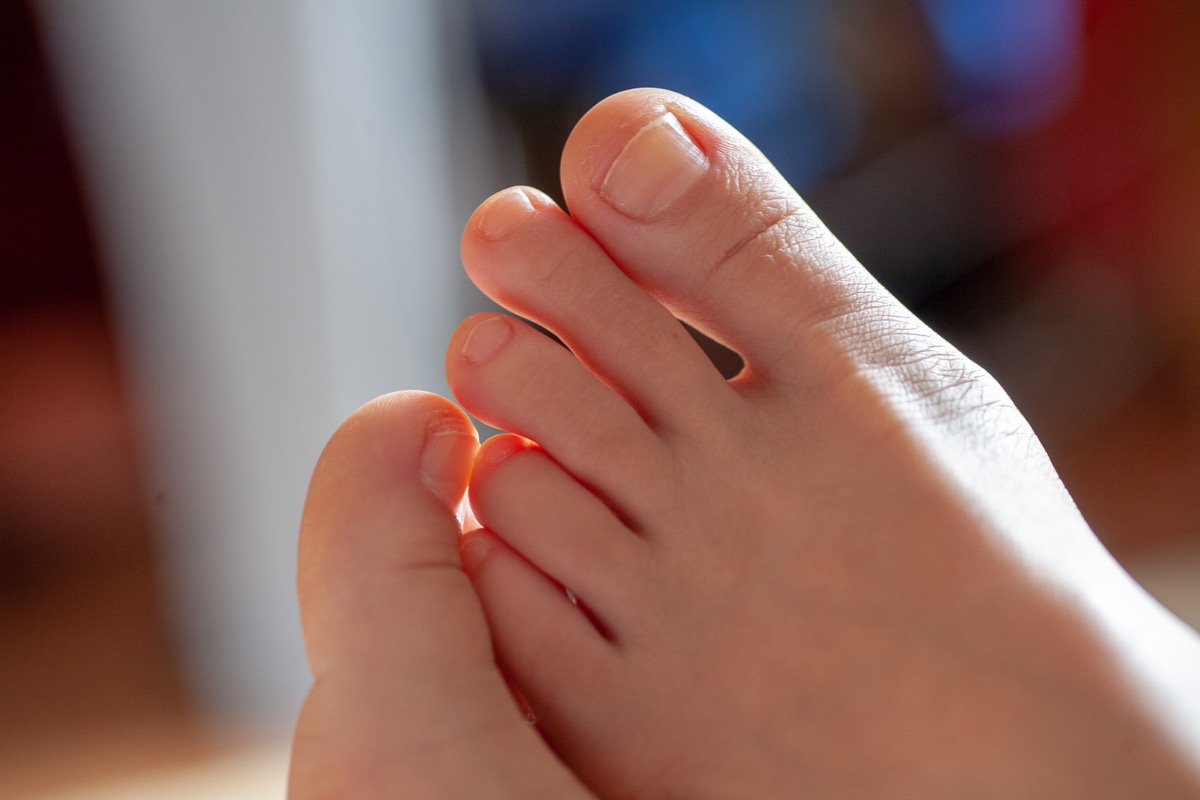When you think of protecting your heart health, the first thing that likely comes to mind is preventing a heart attack. Yet the best way to avoid such a catastrophic event is to first prevent the more subtle heart conditions which can lead to it. One such condition is peripheral artery disease (PAD), a common but serious heart condition that causes the arteries to narrow over time. A 2005 study published in the medical journal BMC Cardiovascular Disorders found that 33 percent of patients with PAD died within five years of their diagnosis.
That's exactly why it's so essential to notice the signs of less often discussed heart conditions, PAD in particular. Specifically, experts are now sharing that there's one little-known symptom which you may notice on your toenails that could tip you off to the problem. Read on to find out which subtle sign to look out for, and what your doctor may recommend doing about it.
RELATED: If You Notice This While Lying on Your Back, Get Your Heart Checked.

Peripheral artery disease (PAD) is a form of cardiovascular disease that currently affects 6.5 Americans over the age of 40. It occurs when fatty deposits of cholesterol build up on the inner walls of the arteries, a process called atherosclerosis. While not immediately life-threatening, PAD makes you more likely to develop other heart health issues, including heart attack, stroke, coronary heart disease, and angina, warns the U.K.'s National Health Services (NHS). Because PAD most commonly affects the arteries in the legs, many people with the condition notice symptoms in their legs and feet. Those with PAD often report having "brittle, slow-growing toenails," says the NHS.
According to the USA Vascular Centers, this occurs because the capillaries located under the nail bed need an oxygen-rich blood supply for nails to grow. As blood flow becomes restricted thanks to narrowed arteries, the growth of your toenails may slow, and the color and texture of your nails and nail beds may change. "At first, you may notice a toenail not growing as quickly as it once did. As the plaque buildup increases, toenails not growing properly is common," their experts explain.
RELATED: Drinking This Just Once Increases Your Heart Disease Risk, Warns Mayo Clinic.

While many people with PAD experience no symptoms at all, others notice signs of the condition in the lower half of their body. According to the NHS, the most common symptom is a painful, intermittent ache in the legs, which can be mild or severe and affect one or both legs. Many patients also experience cramping which begins in the toes, and travels up the calves—especially while walking or doing other physical activity, says The Froedtert & Medical College of Wisconsin.
Besides pain and slow growing toenails, PAD patients also frequently experience hair loss on the legs and feet, numbness or weakness in the legs, ulcers on the legs and feet, shiny skin in the lower extremities, changes in skin color on the legs, and erectile dysfunction in men.
More severe symptoms of PAD may indicate a related condition, known as critical limb-threatening ischemia (CLTI), say experts from The Froedtert. This condition causes "serious blockage of the arteries that severely limits blood flow to the arms or legs. It can cause pain while sleeping or at rest, and can lead to open sores or wounds on the toes, feet or legs that don't heal or heal very slowly. Left untreated, this condition can lead to amputation of the affected limb," they warn.

If you do notice any of these symptoms, it's crucial to bring them to your doctor's attention, says the Centers for Disease Control and Prevention (CDC). "Your doctor may do an ankle brachial index (ABI), which is a noninvasive test that measures the blood pressure in the ankles and compares it with the blood pressure in the arms at rest and after exercise. Your doctor may also do imaging tests such as ultrasound, magnetic resonance angiography (MRA), and computed tomographic (CT) angiography," the health authority explains.
Once your doctor has diagnosed the condition and determined its severity, there may be a range of possible treatment options available to you. In less severe cases, your doctor may recommend taking a daily aspirin or anti-platelet medication to increase blood flow and prevent complications related to PAD. In more severe cases, your doctor may recommend surgery to bypass blocked arteries, says the CDC.
For more health news sent directly to your inbox, sign up for our daily newsletter.

If you do suspect that you may be developing PAD or any other heart health issue, you should start managing your risk factors today. Primarily, this entails controlling any chronic condition you may have which makes PAD more likely, such as diabetes, high cholesterol, high blood pressure, or heart disease. Experts also say that maintaining a healthy weight through diet and exercise can help prevent PAD and minimize its complications.
Finally, studies show that up to 80 percent of those with PAD are current or former smokers, says the American College of Cardiology. If you currently smoke, quitting can greatly reduce your symptoms and risk of complications.
RELATED: If You Notice This While Walking, It Could Be a Heart Attack Warning Sign.
"condition" - Google News
February 15, 2022 at 07:03PM
https://ift.tt/gE9LZwu
Brittle Toenails Can Be a Sign of a Heart Condition — Best Life - Best Life
"condition" - Google News
https://ift.tt/ygOnV0s
https://ift.tt/T1KeGA4
Bagikan Berita Ini

















0 Response to "Brittle Toenails Can Be a Sign of a Heart Condition — Best Life - Best Life"
Post a Comment